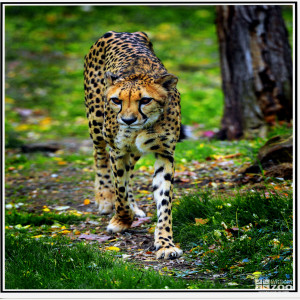Cheetah
[Acinonyx jubatus]

The cheetah, with its long legs, deep chest and narrow waist, help to make it is easy to see why this is the world's fastest land mammal (to 68 mph). The extremely flexible spine permits long bounds while running, and wide nostrils allow sufficient entry of air into the lungs to facilitate the great speed. The muzzle is short and the eyes set high on the head. The nostrils are wide, and the ears small and rounded. The claws do not retract fully and are partially exposed to give traction during fast turns and rapid acceleration. The short, coarse fur is tawny yellow with round black dots. The cheetah has distinctive "tear-lines" running from the inner corners of the eyes to the outer corners of the mouth. Head and body length is from 44 to 53 inches, the tail from 26 to 33 inches, and the weight ranges from 86 to 143 pounds. Cheetah cubs under 3 months of age have a "mane" of blue-gray hair on the nape of the neck and the back.
Location: Primate & Cat
Future For Wildlife
Share:
Range
The Cheetah is native in Africa, Iran, parts of Pakistan and Afghanistan.
Habitat
The cheetah's habitat includes open areas from semi-desert to open grasslands, and thick brush.
Conservation Status
VulnerablePrimary Threats
Human Wildlife CoexistenceGestation
Gestation in cheetahs occurs in 90 to 95 days.
Litter
Cheetah litters can be from 1 to 8 kittens, but usually are 3 to 5.
Behavior
Female cheetahs are solitary and do not defend a territory. Several females, both related and unrelated, may share large, overlapping home ranges. Males may join together in small groups, called coalitions, to defend a small territory. In contrast with other cats, females may have a range in excess of 5 times the size of a male's. They eat only prey they have killed themselves (in the wild), and will not consume carrion. They eat the heart and kidneys first, drink the blood, then consume the head and finally the muscle meat.
Reproduction
The young cheetahs are weaned by the time they are 6 months old. They leave their mother at 12 to 20 months. Siblings may remain together for several more months. Infant mortality is high during the first 3 months — 90% in some areas. Lions will kill cheetah cubs whenever they find them undefended.
If a female loses her litter during the first 4 months, she will come back into estrus within days. Cubs begin hunting small birds at 3 months, although they rarely catch them. At 5 months they begin chasing small mammals. By 8 months they are mostly stalking large prey. When they separate from their mother they are still poor hunters. They do not become proficient until about 3 years of age. There is usually a 17 to 20 month interval between litters.Wild Diet
A cheetah's diet in the wild includes gazelles, impala, wildebeest calves, and hares.
